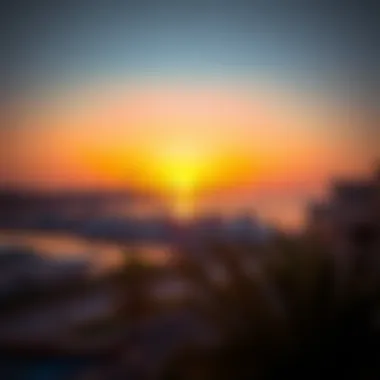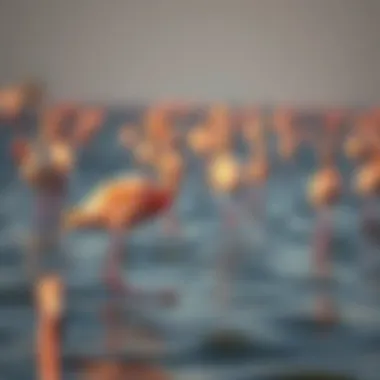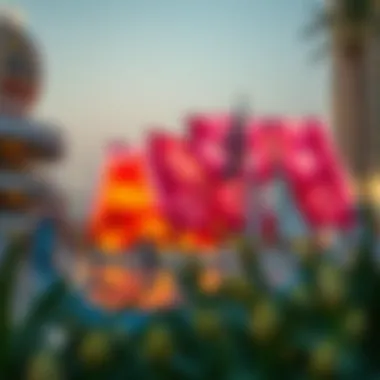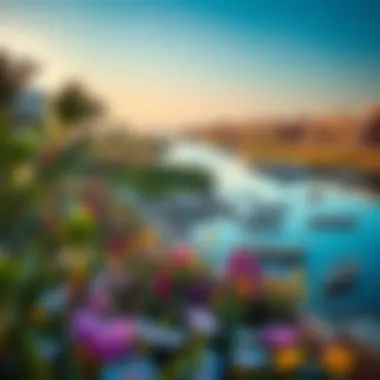Discovering Ras Al Khor Creek Harbour: Dubai's Hidden Jewel


Intro
Ras Al Khor Creek Harbour serves as a fascinating blend of natural beauty and cultural richness in the bustling heart of Dubai. This deceptively tranquil spot offers both residents and visitors a chance to explore the intertwining narratives of the city’s maritime history and its vibrant ecological surroundings. The local wildlife, particularly the flamboyant flamingos, coexists alongside the modernity of Dubai, showcasing a harmony that is often hard to find in urban landscapes. This article sets off on a journey through various facets of Ras Al Khor, from its historical significance to the ecological wonders it holds.
By understanding the deeper layers of this location, one can appreciate how Ras Al Khor has become not only a haven for nature lovers but also a cultural touchstone that reflects the community's values and traditions. As urbanization hums along in Dubai, preserving these areas of ecological and cultural significance becomes critical to maintaining the essence of what makes the region unique.
Through different perspectives—from history buffs to environmental advocates—we aim to connect the dots, showing how Ras Al Khor stands out as a natural and cultural gem amid the rapid pace of modern development.
Preface to Ras Al Khor Creek Harbour
Located in the bustling metropolis of Dubai, Ras Al Khor Creek Harbour holds a unique blend of natural beauty and cultural significance. This area is not just any estuary; it symbolizes the rich marine heritage and biodiversity that the emirate boasts. With its crucial role in both ecological preservation and urban development, understanding Ras Al Khor is fundamental for anyone interested in the intricate balance between nature and human activity in contemporary Dubai.
Ras Al Khor means ‘Head of the Creek’ in Arabic, aptly describing its location where the waters of the Arabian Gulf meet the Dubai Creek. The harbour is a breeding ground for various marine species and shorebirds, making it a critical habitat that deserves attention. As Dubai continues its rapid urbanization, the importance of this natural oasis becomes even more pronounced. It serves not only as a sanctuary for wildlife but also as a hub for cultural exchange and community involvement, drawing tourists and residents alike to its shores.
This section of the article aims to lay the groundwork by addressing the geographical layout alongside the rich history that forms the backbone of Ras Al Khor Creek Harbour. By exploring these aspects, readers can develop a deeper appreciation for its attributes and the delicate balance it maintains amidst an encroaching urban landscape.
Geographical Overview
Ras Al Khor Creek stretches over an impressive expanse of around 6.2 kilometers. It's flanked by prime areas of Dubai, making it a paradoxical meeting spot of pristine nature and urban sophistication. The harbour is characterized by its intricate saline wetlands, mudflats, and mangroves, providing a vital stopover for migratory birds travelling on the East Africa-West Asia flyway.
The coastline is dotted with numerous lagoons and channels, rapidly becoming a favorite spot for birdwatchers and nature enthusiasts. This geographical diversity supports over 450 species of animals, including fish, invertebrates, and birds. In particular, it is renowned for being home to the beautiful flamingos that flock to the area, especially during winter months. The varied ecosystems within Ras Al Khor also act as an essential buffer, improving water quality and serving as natural flood controls.
As visitors stroll along the paths that line the creek, they often find themselves stopping to observe the elegant flight patterns of these celebrated birds. The tranquility of the environment juxtaposes the skyline of Dubai, reminding onlookers of the coexistence of nature with rapid modern development.
Historical Significance
The historical roots of Ras Al Khor Creek Harbour are as rich and layered as the estuary itself. Initially, this area served as a bustling center for trade and commerce. It was a vital hub for pearling and fishing, activities that were intrinsic to Dubai's economy before the oil boom transformed its landscape.
Artifacts unearthed from the surrounding areas indicate human activity dating back to the Bronze Age, highlighting its historical importance. The sediment layers along the Creek preserve stories of the past, offering an insight into the ways in which people have interacted with this resource over centuries. Engaging with the past is essential as it informs contemporary efforts towards conservation and development, aiming to protect not just the wildlife but also the rich cultural narrative that Ras Al Khor symbolizes.
In recent years, initiatives have sought to preserve this heritage. The establishment of the Ras Al Khor Wildlife Sanctuary in 1998 was one such step towards recognizing the significance of the area. It is essential to acknowledge that as we delve deeper into modern cultural aspects and community involvement in Ras Al Khor, understanding its historical context offers invaluable insights into current conservation efforts.
Ecological Characteristics of Ras Al Khor
Ras Al Khor Creek Harbour is not just a picturesque location in Dubai; it serves as a vital ecological sanctuary. The ecological characteristics of this harbour are central to its importance, offering a unique habitat that supports various species and contributes to the region's environmental health. Understanding these ecological elements allows locals and visitors alike to appreciate the balance of urban life and nature.
Flora and Fauna
The sheer diversity of life in Ras Al Khor is breathtaking. The mangroves lining the coast act as natural barriers, protecting both the shoreline and the harbour's delicate ecosystem. They provide a breeding ground for numerous species. Tall, lush Avicennia marina mangroves are particularly prominent, their roots extending into the water and offering sanctuary to young fish, crabs, and even some bird species. Coupled with this, the area is a temporary home for migratory birds, such as flamingos and egrets, particularly during the winter months.
"Ras Al Khor's wetlands are like a lifesaver for many species, offering a critical stopover on their migratory journeys."
In addition to birds, you can find various fish species, mollusks, and crustaceans, all of which contribute to a complex and thriving aquatic ecosystem. Marine life flourishes thanks to the nutrient-rich waters, making it an essential spot for biodiversity. This interaction between land and marine environments highlights the importance of protecting such ecosystems—both for the species living there and for the larger environmental context.
Wetland Conservation Efforts


Conservation in Ras Al Khor is not merely an afterthought; it's a core principle guiding various initiatives. Several organizations work tirelessly to ensure that the natural habitat isn't compromised by urban expansion. Among these efforts, the establishment of the Ras Al Khor Wildlife Sanctuary is noteworthy. This sanctuary signifies a commitment to safeguarding the unique ecological aspects of the area through both habitat preservation and public education.
Regular community programs aimed at raising awareness about local wildlife and environmental sustainability help engage citizens and visitors alike. Guided tours through the wetland areas allow people to witness the beauty of the landscape while learning about the delicate balance of life within it. Effective waste management strategies and renewable energy projects are also crucial components of the broader conservation narrative in Ras Al Khor.
By understanding what's at stake, it becomes easier to appreciate the integral role of these ecosystems in Dubai's identity, and why ongoing conservation efforts are essential for future generations.
Cultural Significance of the Harbour
The cultural tapestry of Ras Al Khor Creek Harbour is not just woven from the threads of its natural beauty but also shaped by its vibrant artistic expressions and community involvements. This area stands as a reflection of Dubai's unique blend of tradition and modernity, presenting a vital aspect of the city's identity that attracts both tourists and locals alike. The harbor's cultural significance is rooted in its ability to foster connections among people, promote creativity, and enhance community spirit.
Local Art and Installations
Art is a powerful medium through which communities express their shared experiences, and Ras Al Khor Creek is no exception. The harbor features various installations and art pieces that not only celebrate local heritage but also engage the community. For instance, the Dubai Creek Art Project has seen numerous artists transform natural settings into canvases for their creative expressions. Murals adorned with colorful depictions of native birds and marine life can be spotted throughout the area, infusing everyday environments with a splash of artistry.
The artwork often draws inspiration from the surrounding wetlands, capturing the essence of wildlife and the balance of nature. Additionally, community art workshops held near the harbor encourage participation from residents, especially children, fostering a sense of ownership and pride in their surroundings. Such projects ignite enthusiasm for local culture and help bridge generational gaps through the shared experience of artistic creation. The visual and interactive nature of these installations also encourages visitors to pause and reflect on the inherent beauty of the ecosystem—reminding everyone of the vital relationship between culture and nature.
Community Engagement and Activities
At the heart of Ras Al Khor Creek lies a commitment to community engagement that is evident through various activities organized throughout the year. These range from educational programs about the rich biodiversity of the area to environmental clean-up drives that promote stewardship of the harbor. Local schools and organizations often collaborate to hold workshops, guiding participants on how to sustainably interact with their environment. As a result, many residents grow up knowing the importance of conservation and the role of wetlands in their local ecosystem.
Moreover, events such as the Ras Al Khor Festival attract visitors from various walks of life. It blends cultural performances, food stalls, and engaging activities centered around the rich history of Dubai's maritime traditions. This festival not only showcases local talent but also strengthens the ties within the community, celebrating diversity and shared heritage.
In essence, the plethora of activities at Ras Al Khor goes beyond mere recreation; they foster a communal bond and instill a sense of belonging among residents and visitors alike. With the harbor acting as a cultural hub, it becomes a thriving space where art meets engagement, ultimately enriching the lives of those who interact with it.
"Ras Al Khor Creek Harbour is more than just a serene escape; it is a living testament to the harmony between art, nature, and community involvement in Dubai."
The cultural significance of Ras Al Khor serves as a crucial reminder of how urban environments can embrace and uplift the arts while preserving a sustainable connection to nature. Through local art and community initiatives, the harbor facilitates an exploration of identity, aimed at nurturing future generations.
Tourism and Recreation Opportunities
Ras Al Khor Creek Harbour is more than just a scenic spot in Dubai; it’s a hub for both tourists and local residents alike, making it a vital link between nature and leisure. The opportunities for tourism and recreation here are vast, enhancing the experience of anyone who visits this eclectic area. The blend of serene natural beauty with accessible leisure activities offers something suited for every taste.
Visiting the Harbour
When it comes to visiting Ras Al Khor, timing and purpose matter. Open from sunrise to sunset, the best hours to explore might be right at dawn or late afternoon, when the sunlight paints the landscape with golden hues. This place is not just for those who love to bird-watch, even though it’s home to thousands of migratory flamingos during the cooler months. Families come for picnics, couples for a quiet walk, and photography enthusiasts for capturing the elusive beauty of nature. There’s no charge for entry, making it an easy choice for a spontaneous outing.
- Wildlife Watching: The serene atmosphere makes it a paradise for bird-watching enthusiasts. Binoculars, a sunhat, and an open heart are all you need to appreciate the variety of species that you might encounter here.
- Strolls Along the Creek: The well-maintained walking paths allow for leisurely strolls while providing perfect spots for capturing that Insta-worthy shot. Whether it’s the skyline as a backdrop or the tranquil wetlands, the creek offers endless angles.
- Safety and Amenities: With nearby facilities such as restrooms and shade, visitors can enjoy their time without much hassle. Just make sure to stay hydrated, especially during the hotter months.
Excursion and Tour Options
For those looking for a more immersive experience, organized excursions offer a fantastic way to explore Ras Al Khor Creek Harbour. Different tour operators provide various packages, whether a guided nature walk or a cruising trip on a traditional dhow. Here are some noteworthy options:
- Guided Bird Watching Tours: These tours dive into the ecological richness of the area. Experts will walk you through the best spots, sharing insider knowledge that’s often hard to find in mere guidebooks.
- Kayaking Adventures: A unique way to experience the waterway is from a kayak. Paddling through the mangroves not only grants you an up-close look at the wildlife but also offers an exhilarating sense of adventure.
- Photography Tours: For those keen on capturing the beauty of Ras Al Khor through a lens, specific tours focus on the best times and locations to snap pictures. Some packages even include gear rental for those who may not own a state-of-the-art camera.
"Ras Al Khor is not just a location; it’s an experience that blends nature’s wonder with the spirit of Dubai's urban landscape."


- Educational Workshops: Often organized through local environmental groups, workshops focusing on ecology and conservation are available. These programs aim to raise awareness and educate visitors about the delicate ecosystem in Ras Al Khor.
- Boat Tours: Companies offer boat trips that allow for a leisurely cruise to learn about the significance of the harbour’s water system. These excursions can vary from short jaunts to longer, more comprehensive explorations, catering to different interests.
In essence, Ras Al Khor Creek Harbour presents tourism opportunities that are both enjoyable and enlightening. It encourages exploration while fostering a deep appreciation for the environment. Whether you are a newcomer or a seasoned resident of Dubai, the harbour has a wealth of experiences waiting to be uncovered.
Sustainability Initiatives
The significance of sustainability initiatives at Ras Al Khor Creek Harbour cannot be understated. Situated in the heart of Dubai, the harbour is more than just a scenic spot; it's a vital ecological habitat and a cultural treasure. With the rapid pace of urban development, the need to protect these natural resources is increasingly paramount. Sustainability efforts not only aim to preserve the delicate balance of life here but also establish an example of responsible stewardship for other regions.
Key elements of these sustainability initiatives encompass renewable energy projects and comprehensive waste management strategies. Each element plays a crucial role in mitigating the environmental impact of urban expansion while enhancing the area's ecological resilience.
Renewable Energy Projects
Ras Al Khor is embarking on a journey towards renewable energy that aligns with Dubai's broader sustainability goals. Solar energy, one of the star players in this initiative, is making waves in the area. Solar panels can be seen popping up on various structures, contributing to the electricity needs of the harbour. This shift not just reduces the carbon footprint but also sets a precedent for energy efficiency.
Additionally, the local government is exploring innovative partnerships with renewable energy companies. These collaborations aim to harness wind and solar resources in synergistic ways, optimizing energy use within various facilities. For residents and tourists alike, it's a chance to witness the transformation of a local ecosystem into a model of sustainable living.
"Sustainability isn't just a goal; it's a way of life that we need to embrace for future generations."
Moreover, educational programs and workshops are being implemented to raise awareness about the importance of sustainable practices. Residents and visitors are encouraged to engage in these initiatives, reinforcing a community-wide commitment to a greener future.
Waste Management Strategies
Waste management strategies in Ras Al Khor are equally impressive. The area has adopted a multi-faceted approach, incorporating recycling programs and waste segregation systems. An integrated waste management system is crucial in handling the increase of waste generated by both the local community and numerous tourists visiting the harbour.
One major component is the implementation of "smart bins". These bins not only collect waste but can also sort recyclables automatically, making it easier for individuals to dispose of their waste responsibly. This tech-savvy approach reduces landfill dependence and promotes recycling practices.
In partnership with local schools and organizations, the harbour facilitates educational campaigns aimed at instilling the values of sustainability from a young age. Programs that stress the importance of reducing, reusing, and recycling are aiming to cultivate a generation that prioritizes environmental health.
The synergy between these waste management strategies and renewable energy projects presents a holistic approach to sustainability at Ras Al Khor. By lowering the ecological impact through innovative practices, the harbour stands as a beacon, showing that growth and preservation can indeed go hand in hand.
For those interested in learning more about sustainable practices, the local government’s website and several environmental NGOs offer resources that delve deeper into community efforts and individual actions that can contribute to a more sustainable future in Dubai.
Visit: Dubai Sustainability for additional information.
Impact of Urbanization
Urbanization around Ras Al Khor Creek Harbour presents itself as a double-edged sword. On one side, it brings forth a slew of developments that could drive economic growth and prosperity for the region. Meanwhile, it begs the question of how to maintain a balance between progress and preservation. The importance of examining this impact is crucial within the frame of this article, especially considering how urban pressure can affect both human activity and environmental health in Dubai.
Development Around Ras Al Khor
The development surrounding Ras Al Khor is a vivid reflection of Dubai's ambitious goals. Large-scale real estate projects and infrastructural enhancements are sweeping the area. The construction of luxury hotels, residential complexes, and commercial spaces has significantly increased the inflow of tourists and residents alike.
Some notable projects include:
- Dubai Creek Harbour: A multi-billion dollar initiative to enhance the waterfront experience.
- The Lagoons: Planned residential spaces that promise luxury living beside beautiful water views.


This transformation fuels economic growth, creating jobs and attracting international investment. Such initiatives showcase Dubai’s commitment to constantly reinventing itself and boosting its stature on the world stage. But with every gleaming skyscraper, there comes environmental considerations that cannot be overlooked.
Challenges to Balancing Growth and Conservation
As development steamrolls ahead, the environmental costs raise red flags. Balancing the appetite for urban expansion with the need to protect natural habitats is a significant challenge. Ras Al Khor is home to diverse wildlife, and habitat degradation poses a serious threat to its eco-balance.
Key challenges include:
- Habitat Destruction: With urban sprawl, many native plants and animal species face the danger of displacement.
- Pollution: Increased development leads to more waste and runoff, affecting water quality in the creek.
- Noise and Light Pollution: Human activities can disrupt the natural behaviors of the local fauna, especially migratory birds that rely on the area.
Strategies to mitigate these impacts are already in play. For example, local authorities are focusing on integrating green architecture into new developments, preserving mangroves, and implementing strict regulations on construction to safeguard habitats.
"The flourishing of urban spaces should not come at a cost to our natural treasures. It's imperative to ensure that development is sustainable and responsible."
Future Prospects for Ras Al Khor Creek Harbour
The future of Ras Al Khor Creek Harbour stands at a fascinating crossroads, intertwining growth with ecological stewardship. As Dubai continues to evolve, the harbour becomes increasingly significant for urban development, conservation, and the enrichment of community life. Recognizing its potential is paramount for both residents and visitors, as the decisions made today will influence the harbour's sustainability and usability for generations to come. With the rise of urbanization, understanding this topic is essential to appreciate the intricate balance of preserving a unique ecosystem while fostering a thriving community surrounding it.
Planned Developments
Future developments around Ras Al Khor Creek Harbour are poised to enhance both its utilitarian and aesthetic values. Authorities are keen on integrating eco-friendly design principles into new structures. For instance, proposals include:
- Eco-Tourism Venues: Plans are in the pipeline to build eco-friendly hotels and restaurants that embrace the surrounding environment. This initiative aims to attract tourists while minimizing the ecological footprint.
- Infrastructure Improvements: Enhancements to transport links are being looked at. By improving accessibility, more individuals can visit and appreciate the area's beauty without compromising its sanctity.
- Cultural Centers: There are discussions of establishing art spaces that showcase local talent and heritage inspired by the rich surroundings, offering a glimpse into Dubai’s culture intertwined with nature.
Such developments are expected to appeal to locals and international tourists alike. By harmonizing modern architectural concepts with natural beauty, the harbour can become a true reflection of Dubai’s identity and aspirations.
Long-term Conservation Goals
Conservation efforts will play a critical role as development unfolds. Balancing growth with the protection of the harbour's unique ecosystems is vital. The key goals for the coming years include:
- Habitat Restoration Initiatives: Plans to restore native habitats, focusing on preserving mangroves as they are crucial to local wildlife and shoreline prevention against erosion.
- Community Engagement Programs: Initiatives that promote educational activities highlighting the importance of conservation will involve schools and organizations.
- Wildlife Protection Policies: Legal frameworks are being discussed to protect local fauna, ensuring migratory birds and aquatic life have safe habitats.
In essence, these long-term goals aren't just about preserving the environment; they represent a holistic approach to ensuring that Ras Al Khor remains a cherished haven for both people and nature. The outlook is promising, with a collective effort from all stakeholders playing a crucial role in securing this harbour's future for many years to come.
"The future of Ras Al Khor Creek Harbour depends not only on development but also on understanding the intrinsic value of preserving nature intertwined with our urban narrative."
Closure
As we wrap up the exploration of Ras Al Khor Creek Harbour, it's clear that this locale serves as a vital bridge connecting Dubai's cultural heritage with its ecological wealth. The significance of this harbor extends beyond its picturesque views and rich biodiversity; it represents a commitment to sustainable development amid a rapidly urbanizing environment. This charm isn't merely in its beauty, but in its role as a sanctuary for both wildlife and local communities.
Summary of Key Points
- Ecological Importance: Ras Al Khor is home to a variety of species, including migratory birds like flamingos, making it crucial for biodiversity in the region.
- Cultural Heritage: The harbor reflects the historical and contemporary culture of Dubai, from local art installations to community activities that engage both residents and tourists.
- Sustainability Efforts: Various programs aim to balance urban growth with conservation, ensuring that the ecological aspects of the harbor are protected for future generations.
- Tourism and Recreation: Visitors can experience the beauty of nature and culture through various excursions and community events, enhancing awareness of environmental issues.
Call for Continued Awareness
It's beneficial for everyone—tourists, residents, expatriates, students, and professionals—to stay informed about the ongoing initiatives at Ras Al Khor Creek Harbour. Awareness fosters advocacy, encouraging protective measures for this natural and cultural gem. The local community, government bodies, and international organizations can all play a role in preserving the delicate balance between development and conservation.
Let’s not forget, our actions directly impact the future of this unique ecosystem. Regular visits, community events, and simply spreading the word about Ras Al Khor can play an influential part in safeguarding this remarkable harbor. It isn’t just a destination; it��’s a legacy worth preserving.
In summary, continuing to engage with and support Ras Al Khor Creek Harbour can help ensure its preservation, allowing us all to appreciate its beauty and importance for years to come. For more information on conservation efforts and ways to get involved, you can visit Ras Al Khor Wildlife Sanctuary or Dubai Tourism.



